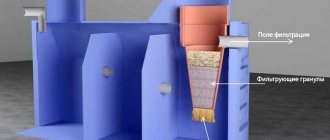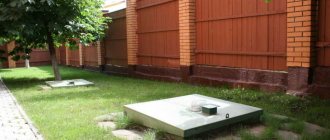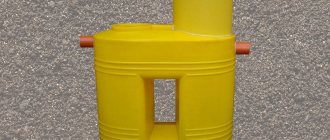Question-Answer/Questions and answers on the installation of septic tanks/Why did the septic tank float up?
Is it possible to install the compressor outdoors or inside the unit?
The septic tank smells - what to do?
Winter is over, the snow has melted, you are returning to your dacha after a long break, and an unpleasant surprise awaits you there - a septic tank has popped up.
Much has been written and said on the topic “why a septic tank pops up,” but they stubbornly continue to pop up, so let’s look at this problem again.
Consequences of a floating septic tank
For summer residents, such an event turns into a real disaster. They will have to reinstall the septic tank from scratch. The container will have to be completely emptied, removed from the pit, water pumped out from the pit and installation carried out according to the technology established by the manufacturer in accordance with the existing hydrogeological conditions of the area.
The most favorable outcome of what happened is the safety of the container: no deformation, the integrity of the walls, the tightness is not broken. If the damage is minor, the septic tank is restored. In case of serious damage, the container will require replacement - it is incredibly difficult to achieve complete tightness of the broken wall. It is possible that the pipeline will also have to be repaired. The sewer outlet will turn out or break off at the weakest point: at the connection with the septic tank, the point of entry into the house, the place where the pipes are extended.
Our works
October 4, 2019
Maintenance and cleaning of septic tank Tver
Moscow region Odintsovo district village.
Podlipki May 11, 2019
Installation of a septic tank Tver 0.85 PN
Turnkey septic tank installation in Ozersky district.
Object - Moscow Region, Ozersky district, Ledovo village, SNT Ledovo October 27, 2018
Installation of septic tank Tver in Bronnitsy
Tver-0.5PN, installation Ramensky district, Bronnitsy, Nikonovskoye joint venture October 27, 2021
Installation of a septic tank in the village of Ledovo, Tver
Installation of a septic tank in the village of Ledovo, SNT Ledovo, Tver
Dismantling the skeptic Odintsovo district, Nikolina Gora, Uponor Sako
Dismantling the skeptic Odintsovo district, Nikolina Gora, Uponor Sako
Why did the septic tank push to the surface?
Experts identify four general reasons:
- Incorrect installation. In half of the cases, it is incorrect installation that becomes a prerequisite for an emergency situation.
- Violation of VOC restart technology. The manufacturer sets a clear algorithm for rebooting the station - ignoring the recommendations will lead to problems with its ascent.
- Mistakes made when preserving the septic tank at the end of the season. Manufacturers provide certain instructions regarding the preparation of VOCs for wintering. Following them means you are guaranteed to get a working septic tank next season. Otherwise, it is possible that the owner will find VOCs in the spring in a place other than where he left them several months ago.
- Unpredictable rise in groundwater level (GWL). This is, in essence, a force majeure situation. A water main break, an unexpected river flood, abnormally long heavy rainfalls - all this contributes to a sharp increase in groundwater level.
If possible, during the installation process it is necessary to provide for this moment and anchor the septic tank to the concrete base, even if, according to a geological survey of the area, the groundwater lies quite deep.
Septic tank models for 15 people
Septic tank TOPAS 15
| More details | Users: up to 15 people Salvo discharge: 830 l. Processing volume: 3 m3/day Price: 251,550 rub. |
Septic tank TOPAS 15 Long
| More details | Users: up to 15 people Salvo discharge: 850 l. Processing volume: 3 m3/day Price: 291,150 rub. |
How to solve a problem with a pop-up septic tank
A serious illness is treated by experienced doctors who have the necessary medical equipment and medications in their arsenal. It’s the same with the sewerage system: if the septic tank floats up, you should go to professionals for help. The work requires technical means, the ability to apply them in each specific case and the knowledge of what and to what extent to carry out measures to restore the functionality of the wastewater collection system. Specialists:
- determine the causes of the incident to prevent recurrence of the situation;
- re-install the septic tank in compliance with installation technologies and manufacturer’s recommendations;
- repair communications connecting the septic tank and internal sewerage.
It is cheaper and easier to prevent an accident than to correct its consequences. Therefore, it would be right to entrust the installation of an autonomous sewer system of a country house to specialists.
How to prevent an accident
The best solution is not to correct problems, but to prevent them already at the septic tank design stage.
Such actions can not only save money, but also save the time and nerves of private sewer owners
The situation when the septic tank surfaced, and the photos presented below became a reality, is very untidy. To prevent this from happening, just follow a few simple rules:
- Choose a set of autonomous sewerage systems “with a reserve”, based on how many people will constantly live and use communications in the house. Choosing a septic tank based on price rather than functionality and capacity is not the best way to save money.
Septic tank models for 10 people
Septic tank ASTRA 10
| More details | Users: up to 10 people Salvo discharge: 550 l. Processing volume: 2 m3/day Price: 149,000 rub. |
Septic tank BioDeka-10 P-800
| More details | Users: up to 10 people Salvo discharge: 570 l. Processing volume: 2 m3/day Price: 143,000 rub. |
Siltation of the septic tank - causes and solutions
Siltation itself is a natural process for both flow-through models and biological treatment stations. Once every 2-3 years, all such structures require pumping out excess sediment. The problem is that siltation occurs too quickly.
The reasons here may be:
- Lots of organic waste, especially when using waste disposers in the kitchen. It is better to throw all large garbage into a container.
- A large amount of chlorine enters the septic tank, which kills all or most of the bacteria involved in the wastewater treatment process.
- A large amount of toilet paper used - cellulose contributes to silting of structures. It is especially undesirable to use cheap toilet paper, which does not dissolve well in water. It often causes blockages in pipes and overflow systems in the chambers of biological treatment stations. It's better to throw it away separately.
- Leakage of the structure - if there are cracks in the body and water and dirt enter from the outside, excessive siltation of the septic tank is possible. Repairs will be required, and most often, a complete replacement of the structure. The product with cracks in the housing cannot be used.
- Long downtime - if we are talking about an ordinary cesspool, then during downtime the number of anaerobic bacteria may simply decrease. Therefore, their quantity is not enough to process sewage, which is why the cesspool quickly silts up.
What to do if the septic tank is silted - cleaning methods
There are three ways to clean a silted septic tank - mechanically, chemically or biologically. Each method has its own characteristics.
Mechanical cleaning
It involves pumping out a septic tank, biological treatment station or cesspool with a pump for sludge or feces. In addition to the pump, you will need a brush to clean the walls of the treatment plant from fat and silt deposits, a hose of the required length for immersion, and a container for the pumped out liquid. You will also need clean water for washing, which can be supplied under pressure - water from a garden hose or a Karcher. After cleaning the septic tank or biological station from sludge, the structure is again filled with water and pumped out again for better cleaning. Biological treatment stations need to be replenished with clean water to the previous level as quickly as possible so that the structure does not deform when it is empty in the ground. Read more about self-service of biological stations in the data sheet for the product of a particular brand.
However, more often such work is entrusted to professionals, because Most do not have special equipment, and there is no need to buy it. Besides, where to put the pumped out sewage? Therefore, it is easier to hire a specialist with a sewer machine or suction pump, as well as all the necessary equipment, who will do everything himself.
Chemical cleaning
Note! The method is used only for cesspools. It is prohibited to use chemicals for polymer septic tanks and biological stations
For chemical cleaning, they use preparations containing nitrates, because they are the safest for humans and the environment. The product is poured into a storage tank in accordance with the dosage specified in the instructions and covered with a lid. To dissolve sludge, fat deposits and soap residues, you only need to wait 3-6 hours with a cesspool volume of up to 2 cubic meters. When all solid deposits have dissolved, the liquid is pumped out independently using a fecal pump into another container or with a sewer truck, then the tank is washed with clean water to remove chemical residues and contaminants, and pumped out again.
Advantages of chemical cleaning:
- cheap - the product costs on average 500 rubles;
- efficiency - it cleans well of sludge and eliminates the problem for a long time;
- Can be used in winter when it's cold.
Flaws:
- It is unacceptable for cleaning sludge in plastic septic tanks, and even more so in biological treatment stations;
- There is a problem with the release of bacteria into the pit after applying chemicals. Repeated thorough rinsing of the container is required to re-introduce bacteria. Otherwise they will not take root.
Biological treatment
Anaerobic or aerobic bacteria are used to process waste. The former do not need oxygen, the latter need its continuous supply. The quality of dissolution of sludge and fat is the same as in the case of using chemicals. Only this method is safe for humans and the environment. It is aerobic bacteria in combination with aerobes that are used to treat wastewater in modern deep biological treatment plants.
Depending on the type of treatment plant, its own bacteria are selected. The product in the form of powder, granules or tablets is added directly to the septic tank chamber or cesspool, or by pouring it into the toilet/washbasin. Before this, any of them needs to be prepared (read the instructions for the drug for more details). The solids will take 3-10 days to break down. After this, you need to pump out the liquid (it is not necessary to dispose of it specially, you can pour it into a ditch) and rinse the chamber with clean water.
Advantages of biological treatment:
- Guaranteed removal of sludge and unpleasant odors;
- Safety for nature and people;
- Does not require outside help.
Flaws:
- Cannot be used in winter at sub-zero temperatures;
- Cleaning takes longer than with a chemical method;
- More expensive than chemicals.
Unpleasant odor near biological stations
In the case of biological treatment plants, an unpleasant odor clearly indicates a malfunction. Unlike flow-through septic tanks, aerobic bacteria are responsible for the main purification processes in them, which do not emit unpleasant-smelling gases when processing contaminants. This is possible when cleaning processes are disrupted.
Among the most likely reasons are:
- Death of aerobic microflora of “activated sludge” in the aeration tank chamber. May occur after using aggressive chlorine-containing detergents.
- Low load on the cleaning station. As a result, bacteria do not have enough food to reproduce.
- Long power outages cause aeration processes to stop, which also leads to oxygen starvation and death of activated sludge.
The solutions to the problem in the listed cases are clear. Do not use aggressive chemicals, do not allow long power outages and idle downtime. After a long period of inactivity, flushing special bacteria or ordinary semolina into the toilet, which gives impetus to the development of aerobic microflora, sometimes helps to “start up” the septic tank.
Septic tank Kolovesi 8
Add to cart Go to catalog
A floating septic tank means that the sewer network is completely depreciated and cannot operate normally. Often not only the tank is damaged, but also the built-in devices that pump out wastewater and provide a forced supply of oxygen necessary for the normal functioning of aerobic microorganisms. Therefore, a thorough diagnosis will be required, which can only be performed by professionals using the appropriate tools.
Re-installation should begin with the development of design documentation and careful planning of all parameters. We must not forget about the additional fastening of the product to the bottom of the pit, which will prevent a recurrence of the accident. Separately, you will have to take care of repairing the supply pipeline. Even the slightest change in the location of the tank causes disconnection of the inlet/outlet pipes and a violation of the tightness of the system. As a result, wastewater begins to seep into the ground, forming pockets of infection and the spread of foul fumes.
Conclusion
To prevent the septic tank from floating up and having to spend a lot of money on eliminating the consequences of such an accident, you need to follow simple steps. Buy a model of a local treatment plant “with a reserve” so that the system can withstand increased loads and the impact of undesirable natural factors. Saving in this matter can lead to irreparable results.
It is also important to order a geodetic survey of the site before purchasing VOCs from specialized engineers. For areas with high groundwater levels, manufacturers offer special modifications to deep biotreatment stations. Due to the design features of such modifications, the floating of containers under the influence of rising waters is impossible.
Complete emptying of the container is unacceptable to avoid the body being compressed by soil or lifted to the surface under the influence of water currents. In any of these cases, the product will deform and cracks and holes may form. The integrity of the structure largely depends on competently carried out installation work, which can only be guaranteed by professionals in their field.
Difficulties created for sewerage by high groundwater levels
A high level is considered to be water that lies in the ground at a depth of no more than 1-0.5 meters. Because of this, a number of problems may arise when using sewage systems, which can even lead to a local environmental disaster.
Septic tank flooding
Perhaps the most unpleasant thing that can happen is flooding, when due to swelling of the soil, groundwater flows from the ground into the sewer system. Septic tanks consisting of several concrete rings are especially vulnerable to flooding. Water can enter the system through seams that are not always tight, and the tank will fill much faster than expected
In this case, it is important to call the vacuum cleaners in time to pump out the waste. Otherwise, groundwater, along with sewage from the septic tank, can flow through sewer pipes directly into the house
Surfacing of the septic tank
Another serious problem that primarily affects septic tank systems assembled from plastic tanks and not very securely fixed to concrete is floating. In this case, the groundwater rising due to heavy rainfall does not get inside the tanks, but simply squeezes them out of the ground. Because of this, the tanks lose their tightness, the septic tank becomes noticeably tilted, which can ultimately lead to a sewerage break.
As a result, the septic tank suffers irreversible damage, and sewage ends up in groundwater, and the area is flooded. And since groundwater spreads in the soil quite quickly, a significant area can suffer from contamination with fecal matter and accompanying microorganisms. As a result of such a local disaster, nearby streams, rivers and wells become unusable.
Rules for preparing a septic tank for winter
If the house is not planned to be used in winter, then preservation of the autonomous cleaning system is extremely necessary. Next, we’ll look at how to prepare a septic tank for winter.
There are two paths you can take - turn to specialists or do conservation yourself. With any choice, knowledge of the basic rules for performing this procedure will not be superfluous and will help to avoid breakdowns in the sewer system.
This is interesting!
How to clean a septic tank without pumping: a review of effective methods Read more
If you are using a factory-made septic tank, then you need to study the instructions describing the procedure for preparing it for winter. The steps of the operation may vary slightly for different models.
The first thing that needs to be done before mothballing the biochemical treatment station is to pump out the sludge from the bottom of the receiving tank. During the winter period, in the absence of constant incoming wastewater, beneficial bacteria will be in suspended animation, and the sludge at the bottom of the septic tank will begin to decompose and poison the contents.
The next step is to de-energize all systems and elements of the septic tank. Next, you need to partially dismantle the compressor with the pump, remove the filters and pipes and wash them. Also clean and wash the hoses and container walls. Store all removed parts in a dry place until spring.
After this, you need to fill the tanks two-thirds with water. As previously mentioned, completely pumping out the liquid is a common mistake. The water in the septic tank helps prevent the septic tank from deforming and floating in the spring, and also keeps the necessary beneficial bacteria alive. Additional protection against deformation of the walls of the septic tank will be floats placed in the chambers, which can be made from ordinary plastic bottles with a volume of 1.5–5 liters. It is necessary to partially fill them with sand so that they float upright in the water. This is necessary to compensate for the pressure on the walls of the septic tank when ice forms in the tanks.
A couple of weeks before the start of the cold season, special bacteria should be added to the system to enhance the vital activity of beneficial microorganisms. This action will facilitate their rapid reproduction and resumption of waste treatment activities after re-opening in the spring.
And one more point in the question of how to prepare a septic tank for winter is insulating the lid and upper part of the structure. Thermal insulation materials suitable for this include sawdust, straw, polystyrene foam, expanded polystyrene, expanded clay, mineral wool and some others.
Hygroscopic materials, on the contrary, should be avoided, as they lose their thermal insulation properties after absorbing moisture.
Septic tank models for 4 people
Septic tank ROSTOK Countryside
| More details | Users: up to 4-5 people Salvo discharge: 2400 l. Processing volume: 0.88 m3/day Price: 48 780 |
Septic tank AK ROSTOK Country Lux
| More details | Users: up to 4-5 people Salvo discharge: 900 l. Processing volume: 0.9 m3/day Price: 100 925 |
Cloudy and dirty water from a septic tank
The problem relates to biological treatment stations, since normally they produce almost clear, odorless water, which can even be used for watering trees. Cloudy and unpleasant-smelling water indicates a violation of the normal cleaning processes in the station.
The most common reasons are:
- Leakage of the structure, crack;
- Failure of the pump/compressor, with disruption of circulation processes;
- Insufficient or excessive load;
- Use of aggressive chemistry.
In other words, any significant failure in the operation of a biological treatment plant will affect the purity of the outlet water. Diagnostics should be carried out in stages, from simple to complex, gradually eliminating possible problems.
Septic tank models for 5 people
Septic tank AK ROSTOK Cottage Optima
| More details | Users: up to 5 people Salvo discharge: 1000 l. Processing volume: 1 m3/day Price: 106 865 |
Septic tank TVER 1.2PN
| More details | Users: up to 5-7 people Salvo discharge: 450 l. Processing volume: 1.2 m3/day Price: 121,000 rub. |
If the option of a ready-made septic tank is not suitable
If you decide to save money and build a septic tank with your own hands, then you will have to use either a monolithic concrete pour or ready-made plastic cubes. Let's consider both device options.
Septic tank made of PVC cubes. For high-quality installation of cameras, it is necessary to prepare a pit, which should exceed the parameters of the cubes by 20-30 cm. The bottom of the pit is well compacted and a 30 cm thick layer of sand is poured there. A concrete slab is placed on the sand, which will become a reliable anchor for the plastic. Using anchors and chains, the septic tank is securely anchored.
After this, it is necessary to sprinkle the containers with cement and sand. The septic tank chamber is filled with liquid to a depth of 30 cm and sprinkled outside to the same height. Continuing to gradually fill the chamber with water and the distance between the septic tank and the walls of the pit, they move to the top. This technology allows you to insure treatment tanks against soil pressure and subsequent deformation.
After all the cubes are mounted, you need to provide their overflow part with the help of tubes. In this case, be sure to ensure that all joints are sealed. Lastly, the septic tank is covered with a slab to secure it in place. A ventilation pipe is brought outside and access to the hatches is provided, as shown in the video below.











